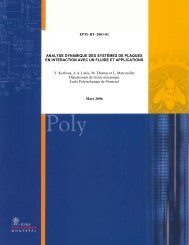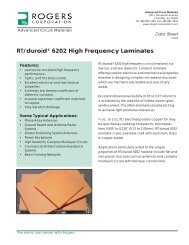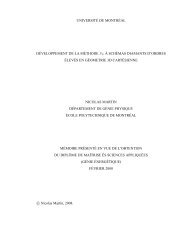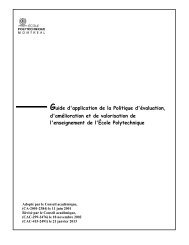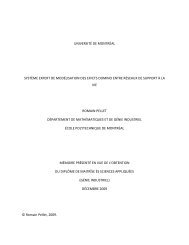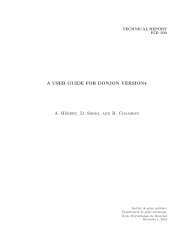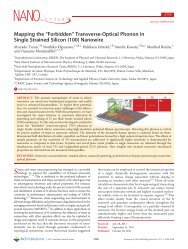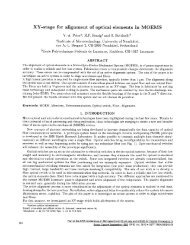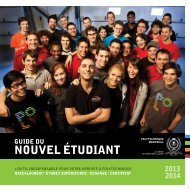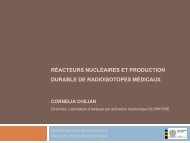Tunable Fiber Laser Using a MEMS-Based In Plane ... - ResearchGate
Tunable Fiber Laser Using a MEMS-Based In Plane ... - ResearchGate
Tunable Fiber Laser Using a MEMS-Based In Plane ... - ResearchGate
Create successful ePaper yourself
Turn your PDF publications into a flip-book with our unique Google optimized e-Paper software.
IEEE JOURNAL OF QUANTUM ELECTRONICS, VOL. 46, NO. 9, SEPTEMBER 2010 1313<br />
<strong>Tunable</strong> <strong>Fiber</strong> <strong>Laser</strong> <strong>Using</strong> a <strong>MEMS</strong>-<strong>Based</strong> <strong>In</strong> <strong>Plane</strong><br />
Fabry-Pérot Filter<br />
Jonathan Masson, Raphael St-Gelais, Student Member, IEEE, Alexandre Poulin,<br />
and Yves-Alain Peter, Senior Member, IEEE<br />
Abstract—We propose a tunable erbium doped fiber laser<br />
based on a Fabry-Pérot (F-P) cavity tuned by an electrostatic<br />
actuator. The device is made of single crystalline silicon. The<br />
F-P cavity consists of two Bragg mirrors, one being displaced<br />
by a comb-drives actuator. The F-P cavity, grooves for optical<br />
fibers and electro-mechanical structure are fabricated by deep<br />
reactive ion etching on a 70 µm silicon on insulator wafer and<br />
are integrated in a ring fiber laser. The resulting tunable fiber<br />
laser has a tuning range of 35 nm in the C-band and a spectral<br />
width of less than 0.06 nm. The maximum applied voltage for full<br />
tuning of the laser is 37 V. The mechanical resonance frequency<br />
of the actuated mirror is 14.4 kHz allowing fast tuning of the<br />
laser. The maximum output power is 1.8 mW.<br />
<strong>In</strong>dex Terms—Er 3+ doped fiber, Fabry-Pérot cavity, laser,<br />
micro-electro-mechanical system (<strong>MEMS</strong>), tunable.<br />
I. <strong>In</strong>troduction<br />
LARGE refractive index difference between silicon and<br />
air and low optical absorption in the telecommunication<br />
frequency range makes silicon an ideal material for optical applications.<br />
With such a large refractive index difference (3.48<br />
for Si and 1 for air) very few periods of a Bragg grating are<br />
needed to get highly reflective broadband dielectric mirrors.<br />
By combining two of these Bragg mirrors, a Fabry-Pérot (F-P)<br />
cavity can be assembled. Recently, several applications based<br />
on in-plane F-P cavities were proposed: tunable filters [1]–[3],<br />
amplitude modulator [4], thermal-mechanical noise sensor [5],<br />
and refractive index sensor [6].<br />
<strong>In</strong> the first part of this paper, we demonstrate a continuously<br />
tunable micro-electro-mechanical system (<strong>MEMS</strong>) F-P filter.<br />
We use a microfabrication process that allows one single<br />
lithography and etch step for the entire device fabrication.<br />
During this process, optical components, electro-mechanical<br />
parts, as well as fiber grooves needed for optical fibers<br />
alignment are fabricated. Compact filters can be designed<br />
and tuned by varying the cavity length. Wavelength tuning<br />
over 104 nm is achieved in the telecommunication C and<br />
L-bands. <strong>In</strong> the second part of this paper, we show an<br />
Manuscript received January 8, 2010; revised March 24, 2010; accepted<br />
April 26, 2010. Date of current version July 23, 2010.<br />
The authors are with the Department of Engineering Physics, École<br />
Polytechnique de Montréal, Montréal, QC H3C 3A7, Canada (email:<br />
jonathan.masson@polymtl.ca; raphael.st-gelais@polymtl.ca; alexandre-<br />
2.poulin@polymtl.ca; yves-alain.peter@polymtl.ca).<br />
Color versions of one or more of the figures in this paper are available<br />
online at http://ieeexplore.ieee.org.<br />
Digital Object Identifier 10.1109/JQE.2010.2050299<br />
0018-9197/$26.00 c○ 2010 IEEE<br />
application of the <strong>MEMS</strong>-based tunable F-P to a continuously<br />
tunable erbium doped ring fiber laser. Wavelength<br />
tuning over 35 nm is achieved in the telecommunication C-<br />
band.<br />
<strong>Fiber</strong> lasers are well known and widely used in industry<br />
because of their high power and relative simplicity. They find<br />
applications as industrial cutting or welding tools [7]. <strong>Tunable</strong><br />
fiber lasers are also good candidates as test and measurement<br />
sources for optical devices characterization because of their<br />
small spectral width, continuous tuning, and stability [8]. Wide<br />
band gain of erbium enables tuning of Er 3+ fiber laser over the<br />
whole telecommunication C and L-bands [9]. Moreover, large<br />
Er 3+ gain offers the opportunity to build powerful lasers or to<br />
use lossy photonic components in the laser cavity for tuning<br />
purposes [10].<br />
<strong>Tunable</strong> fiber lasers using different strategies have been<br />
reported previously [8], [11]–[18]. For example, tunable fiber<br />
Bragg gratings [11]–[13], [15], tunable etalons [14], [17],<br />
polarization controllers [16], and thin film filters [8] were<br />
used. The pitch of fiber Bragg gratings can be tuned either<br />
by mechanical stretching [11], [12] or heating [13]. The<br />
resulting tuning range is however very limited and the tuning<br />
mechanism is usually slow. Therefore, several different Bragg<br />
gratings are needed to increase the tuning range of the fiber<br />
laser leading to a more complicated setup that includes optical<br />
switches and circulators. <strong>Tunable</strong> etalons are external cavity<br />
components requiring complicated alignment systems and are<br />
temperature sensitive [14]. Polarization controllers exhibit<br />
limited tuning range and are difficult to integrate. <strong>In</strong> this paper,<br />
the fiber laser is tuned by a <strong>MEMS</strong> F-P cavity actuated by<br />
an electrostatic comb-drive. Comb-drive actuators are known<br />
to enable fast actuation and large displacements [19]. By<br />
combining <strong>MEMS</strong> actuation to silicon optical devices, we<br />
demonstrate a compact, fast, and wide range wavelength<br />
tunable fiber laser.<br />
<strong>In</strong> the next sections, we introduce the optical and mechanical<br />
design of the device. Simulations describing the F-P behavior<br />
using the transfer matrix method and a gaussian beam approximation<br />
are presented. The fabrication process is detailed and<br />
optical characterizations are shown and compared to optical<br />
simulations. Finally, experimental results of the tunable filter<br />
integrated into a ring fiber laser are reported.<br />
This paper is an extension of preliminary work published<br />
in conference proceedings [20], [21]. By comparison to the<br />
filter of [20], the tuning range is greatly increased (from
1314 IEEE JOURNAL OF QUANTUM ELECTRONICS, VOL. 46, NO. 9, SEPTEMBER 2010<br />
Fig. 1. Scanning electron micrograph (SEM) of the tunable filter integrated<br />
with fiber grooves and electrical contact pads. A set of four springs holds the<br />
movable comb-drive to which the movable Bragg mirror is attached.<br />
73 nm to 104 nm) and simulations are performed which allow<br />
the interpretation of the results in much greater details. By<br />
comparison to [21], the higher quality of the filter allows the<br />
tuning range of the laser to be significantly increased (from<br />
7.7 nm to 35 nm). <strong>In</strong> fact, tuning range improvement is one<br />
of the main contribution of this paper. By comparison to the<br />
very similar filter reported in [3], the design of the <strong>MEMS</strong><br />
actuator allows parallel displacement of the mobile mirror,<br />
which leads to a significant increase of tuning range (from<br />
8 nm to 104 nm). The demonstration of a tunable laser would<br />
not have been possible without this novelty.<br />
II. Device Design<br />
Fig. 1 shows the fabricated device. The F-P filter is made<br />
of two Bragg mirrors made of alternated layers of silicon and<br />
air. The air cavity length is tuned by moving one of the Bragg<br />
mirrors using an electrostatic comb-drive actuator. The other<br />
mirror is static. The comb-drive and the movable mirror are<br />
suspended by a set of four springs. As the voltage applied to<br />
the contact pads is increased, the suspended comb is attracted<br />
toward the static one, bringing the mobile mirror toward the<br />
static one and shortening the cavity length. A smaller cavity<br />
length modifies the filter passband toward shorter wavelengths.<br />
When the voltage is decreased, the mirror goes back to its<br />
initial position (at V =0) because of the restoring force of the<br />
springs. The mechanical design of the springs and actuator is<br />
critical since the movable structure has to be highly stable to<br />
insure that the two mirrors remain parallel over the whole<br />
tuning range of the cavity. Failing to do so will generate<br />
transmission losses and broadening of the passband window.<br />
The use of a comb drive actuator suspended by four simple<br />
beam springs allows parallel displacement of the mobile<br />
mirror, which leads to an increase of the tuning range of the<br />
filter from 8 nm in [3] to 104 nm in this paper.<br />
Light is injected and collected in and out of the filter using<br />
Corning SMF-28 optical fibers. <strong>Fiber</strong>s are self-aligned on each<br />
side of the filter using fiber grooves anf spring holders. This<br />
system ensures alignment loss below 1 dB [22].<br />
Fig. 2. Transmission spectra of four filters with different layer orders. As<br />
the order of the layers increases the transmission bandwidth decreases. The<br />
bandwidth varies from 83 nm to 52 nm when changing the silicon order from<br />
23 to 41 with a constant air order of 11. The bandwidth is maximum when<br />
using silicon and air layers of order 1. The inset numbers correspond to [(N Si )<br />
(N air )(M) (number of Si walls per mirror)].<br />
III. Simulations<br />
Calculations based on a similar method as in [3] and [6] are<br />
used to simulate the filter behavior. The algorithm considers<br />
the divergence of the gaussian beam output from a SMF-28<br />
optical fiber. Sources of errors such as deviation of verticality<br />
of the mirrors and surface roughness are not taken into account<br />
by the model. The transmission spectrum depends on the<br />
number of layers for each Bragg mirror and on the layer<br />
thicknesses. Fig. 2 shows typical transmission spectra for four<br />
different F-P filters made of Bragg mirrors with three silicon<br />
and two air layers, and having increasing thickness of the<br />
silicon and air layers. The thickness d of a layer is linked<br />
to the order N by d = Nλ/(4n), where N is an odd number,<br />
λ is the wavelength, and n is the refractive index of the layer.<br />
The cavity length l is given by l = Mλ/(2n), where M is<br />
the order the F-P cavity. The transmission spectrum of the<br />
F-P exhibits two side lobes, whose separation corresponds to<br />
the reflection bandwidth of the Bragg mirrors. One can see<br />
that as the mirror order increases the reflection bandwidth<br />
of the mirror gets smaller. Thus, a mirror with the largest<br />
possible reflection bandwidth should be made with layers of<br />
order 1. This is an important consideration since the reflection<br />
bandwidth is directly linked to the tuning range of the F-P by<br />
its finesse F given by F(R) =π √ R(λ)/(1−R(λ)), where R(λ)<br />
is the wavelength dependent reflectivity. The reflectivity is low<br />
outside the reflection bandwidth leading to a poor finesse or a<br />
poor transmission. Technology is the limit for the smallest<br />
thickness (order) that can be fabricated with conventional<br />
contact ultraviolet lithography (typically 1 µm feature size)<br />
and with a good precision (higher than 10 nm). Lipson et al.<br />
[3] give a detailed description on the required precision on the<br />
fabrication parameters of such filters.<br />
The reflectivity of a Bragg mirror is directly related to the<br />
number of dielectric layers [23]. Adding layers enhances the<br />
interference effect of the dielectric Bragg mirror, thus increasing<br />
reflectivity of the mirrors. Nevertheless, many periods<br />
Bragg mirrors do not provide the optimal properties in our<br />
configuration. <strong>In</strong>deed, optical fibers output beam waist size is
MASSON et al.: TUNABLE FIBER LASER USING A <strong>MEMS</strong>-BASED IN PLANE FABRY-PÉROT FILTER 1315<br />
Fig. 3. Superposed transmission spectra of a simulated device having an<br />
increasing number of silicon and air layers per Bragg mirror. When the number<br />
of layers is increased, the transmitted peak is narrower but the transmission<br />
losses are higher due to the gaussian beam divergence.<br />
typically 5 µm at 1550 nm, and thus has significant divergence.<br />
Many layers Bragg mirrors are highly reflective. Therefore,<br />
the lifetime of the light in the cavity is very long and losses<br />
increase dramatically as shown in Fig. 3. <strong>Using</strong> one silicon<br />
wall per Bragg mirror the transmission is close to 0 dB, but the<br />
full width at half maximum (FWHM) of the peak is 21 nm. For<br />
three silicon walls per Bragg mirror the transmission drops to<br />
−18 dB and the FWHM to 0.6 nm. We found experimentally<br />
that the optimum number of layers per Bragg mirror is three<br />
silicon layers and two air layers. A beam expander could be<br />
used to circumvent the divergence effect.<br />
For a wavelength of 1550 nm the thicknesses of the layers<br />
are designed to be 2.4 µm and 1.9 µm (corresponding to 21st<br />
and fifth orders) for silicon and air, respectively. Fig. 4 shows<br />
the simulated transmitted spectra of a F-P filter which is tuned<br />
by 88 nm from 1598 to 1510 nm. The inset numbers show<br />
the required displacement of the mirror (in nm) to generate<br />
the corresponding tuning. When there is no displacement the<br />
gapis2.8µm long and the transmission peak is located near<br />
the largest wavelengths (1600 nm). When the gap length is<br />
shortened by actuating the comb-drive the transmission peak<br />
moves toward smaller wavelength. A total displacement of<br />
755 nm is needed to tune through the whole bandwidth of<br />
the filter. The best simulated FWHM for a transmitted peak at<br />
1550 nm is 0.6 nm. As the peak moves closer to the bandwidth<br />
border the FWHM broadens to 2.3 nm.<br />
IV. Fabrication<br />
The filter is fabricated on a silicon on insulator (SOI) wafer.<br />
The device layer of the SOI is 70 µm thick and the silicon<br />
oxide sacrificial layer is 2 µm thick. A 4.2-µm-thick Shipley<br />
SPR 220 3.0 photoresist was used to sustain deep reactive ion<br />
etching (DRIE) processing. The alternate silicon and air layers<br />
of the filter are vertically etched over the 70 µm of the device<br />
layer. The U-grooves for fibers self-alignment, the springs, and<br />
the comb-drive actuator are etched simultaneously.<br />
DRIE was realized in an Oxford <strong>In</strong>struments Plasmalab<br />
System 100. Table I shows the etching parameters. 700 passivation<br />
and etch cycles were applied. The structure was released<br />
by etching the SiO 2 sacrificial layer using 49% concentrated<br />
Fig. 4. Transmission spectra of a simulated device of type [21 5 3 3]. The<br />
F-P gap length is varied from 2.800 µm to 2.155 µm. The numbers over each<br />
peak correspond to the displacement of the movable mirror (in nm) from its<br />
rest position.<br />
TABLE I<br />
DRIE Parameters<br />
Step Passivation Pause Etching<br />
ICP power (W) 450 0 450<br />
RF power (W) 10 0 25<br />
C 4 F 8 (sccm) 65 0 1<br />
SF 6 (sccm) 1 0 65<br />
O 2 (sccm) 0 0 5<br />
Time (s) 4 2 4<br />
liquid HF during 3 min. The anchors and the static comb are<br />
not completely released since they are much larger than the<br />
mobile structures (they stay attached to the remaining oxide).<br />
To prevent the released device from sticking to the substrate,<br />
supercritical CO 2 drying was used.<br />
The inset of Fig. 1 shows the optical part of the fabricated<br />
device. A verticality of 89.5° and a surface roughness of<br />
26.2 nm RMS were reached for the vertical walls. The surface<br />
roughness was measured by an atomic force microscope on<br />
an etched edge.<br />
Verticality was measured using the scanning electron microscope<br />
(SEM) micrograph of a cleaved sample grating<br />
having the same dimension as the filter. It was calculated by<br />
measuring the width of the 70 µm deep trenches at the top<br />
and at the bottom of the region that is in interaction with<br />
the light beam (at trench depths of 5 µm and 15 µm). The<br />
precision of this method is relatively low (a variation of 2 nm<br />
of the measured thickness leads to a deviation of the calculated<br />
verticality of more than 0.01°). Therefore, the reported value is<br />
an upper boundary determined by repeating the measurements<br />
several times. For the experimental results of Fig. 5, it is<br />
possible that the verticality was significantly better. This could<br />
explain that good optical results are reported despite the fact<br />
that, in [3], calculations indicate that verticality better than<br />
89.99° is required.<br />
V. Optical Characterization<br />
A broadband source (Newport BBS-430) was used for the<br />
optical characterization of the F-P. Light is injected into the<br />
device using an SMF-28 optical fiber aligned in the fiber
1316 IEEE JOURNAL OF QUANTUM ELECTRONICS, VOL. 46, NO. 9, SEPTEMBER 2010<br />
Fig. 5. Superposed transmission spectra of the F-P tuned with different<br />
voltage and the corresponding fitted simulation curves (dashed). The inset<br />
numbers show the simulated displacement in nanometers of the movable<br />
mirror to fit the experimental data.<br />
Fig. 6. Transmitted wavelength as a function of the applied voltage to the<br />
comb-drive.<br />
groove. Another fiber is placed on the other side of the F-P<br />
to collect the transmitted light which is guided to an Agilent<br />
86142A optical spectrum analyzer. All results presented in the<br />
following part of the paper were obtained using a filter having<br />
the configuration [21 533].<br />
The filter is tuned by applying a voltage between the static<br />
and the movable comb using a DC voltage source. Fig. 5 shows<br />
the superposed spectra of the tuned F-P filter. The dashed<br />
curves are the simulated fit. At rest, the transmitted wavelength<br />
was 1621 nm. As we increased voltage, the transmitted peak is<br />
shifted continuously toward smaller wavelength. At a voltage<br />
of 40.7 V, the transmitted wavelength is of 1531 nm covering<br />
a tuning range of 90 nm. If the voltage is increased up to<br />
48.5 V two transmitted peaks appear on the same curve. The<br />
separation between those peaks is the free spectral range (FSR)<br />
of the filter (104 nm). This value is the maximum tuning range<br />
of the filter. The spectral width of the filter varies between<br />
4.4 nm and 7.6 nm and losses between −9.46 dB and −24<br />
dB. Fig. 6 shows the transmitted wavelength as a function of<br />
applied voltage to the comb-drive. The linear part of the curve<br />
has a sensitivity of −4.1 nm/V.<br />
The resonance frequency of the suspended structure was<br />
measured using a dynamic white light interferometer (Fogale<br />
Nanotech Photomap 3-D). The first mode appears at 14.4 kHz<br />
Fig. 7. Displacement amplitude of the movable mirror when an AC voltage<br />
is applied to the comb-drive. The first excitation mode resonance frequency<br />
is at 14.4 kHz.<br />
with an in plane deformation. Fig. 7 shows the displacement<br />
of the movable mirror when an AC voltage is applied to the<br />
comb-drive actuator.<br />
To fit the optical simulations with the experimental results,<br />
we have to take into account some fabrication imperfections.<br />
The most important one comes from the over etch caused<br />
by the DRIE. During the silicon etching process, the final<br />
thicknesses of the silicon layers are smaller than the one<br />
defined on the photomask and transferred to the photoresist.<br />
This is due to lateral under etching of the silicon by the SF + 5<br />
ions [24]. Recalling from the definition of the thickness d<br />
of a silicon wall to meet the Bragg condition, the thickness<br />
difference between two consecutive Bragg orders N and N +1<br />
is only 112 nm. This means that an over etch of only 112 nm<br />
in a silicon layer is enough to change N from an odd to an<br />
even number. <strong>In</strong> this case, reflectivity of the Bragg mirrors<br />
drops dramatically so that the F-P performances decrease.<br />
Precise measurement and control of the over etch must be<br />
achieved to obtain good optical results. SEM photographs of<br />
a cleaved grating allowed to estimate this over etch. <strong>Using</strong><br />
the simulation algorithm, the experimental data is fitted by<br />
varying the over etch to find its precise value. The best fit<br />
was obtained for an over etch of 710 nm per silicon layer.<br />
An over etch error on the two silicon walls facing the fiber<br />
grooves was also considered. Since these walls are exposed to<br />
a large etched area (the fiber groove), they are more exposed<br />
to ion bombardment than the inner silicon walls. As an effect,<br />
they are thinner. To have an accurate simulation, an additional<br />
85 nm over etch was considered for these walls. Moreover,<br />
since the F-P gap is larger than the air layers of the Bragg<br />
mirrors, a larger over etch on each side of the air gap must<br />
also be taken into account. <strong>In</strong> this case, 15 nm of over etch<br />
were added in the air gap layer. The displacement of the<br />
movable Bragg mirror needed to tune the filter is finally<br />
fitted using the above-mentioned parameters. Dimensions in<br />
Fig. 5 refer to the displacement needed to tune the filter<br />
at the corresponding wavelength. A maximum experimental<br />
displacement of 629 nm is needed to tune the filter over its<br />
full range. It is close to the predicted 755 nm of displacement<br />
from the simulations (see Fig. 4).<br />
The asymmetric shape of the reflection band of the Bragg<br />
mirrors is explained by the model and is due to the excess over<br />
etch occurring in the larger openings. For an optical cavity, the
MASSON et al.: TUNABLE FIBER LASER USING A <strong>MEMS</strong>-BASED IN PLANE FABRY-PÉROT FILTER 1317<br />
Q factor is linked to the finesse and to the photon lifetime in<br />
the cavity t by Q = λ/FWHM = Fλ/FSR = 2πtν, where ν is<br />
the transmitted frequency. At around 1540 nm, the reflection is<br />
at its highest value and, as demonstrated in Fig. 3, the FWHM<br />
of the peak is the smallest but, since the lifetime in the cavity<br />
is longer, divergence losses are higher.<br />
For resonance peaks located between 1520 nm and 1545 nm,<br />
the difference between the simulated and the experimental<br />
curves increases. Again, this is related to the photon lifetime<br />
in the cavity. When it gets longer, the light interacts more with<br />
the Bragg mirrors and the losses due to imperfections which<br />
are not taken into account by the model (surface roughness,<br />
imperfect verticality) are enhanced.<br />
<strong>In</strong> Fig. 5, it might seam contradictory that the experimental<br />
results sometimes present less loss than the simulated results<br />
of Fig. 4. The reason is that the simulations of Fig. 4 are<br />
performed for a F-P filter having exact nominal dimensions<br />
(odd multiple of a quarter of the central wavelength 1550<br />
nm). Experimentally, this case is never reached perfectly. The<br />
experimental reflectivity of the mirrors is therefore always<br />
lower than the value of Fig. 4. For lower reflectivity, the light is<br />
less confined in the resonator and the losses due to divergence<br />
decrease. <strong>In</strong> Fig. 5, the same simulations are performed using<br />
the real dimensions of the silicon and air layers. <strong>In</strong> this case,<br />
the experimental transmission at the resonance wavelengths is<br />
never higher than the simulations.<br />
Moreover, it should be noted that although the measured<br />
losses of Fig. 5 are sometimes less important than for the<br />
simulations of Fig. 4, the experimental finesse of the F-P<br />
resonance is never higher than expected. Again this is related<br />
to the lower reflectivity of the Bragg mirrors due to over<br />
etching. To summarize, it is not contradictory to obtain lower<br />
than expected losses since this happens at the expense of a<br />
lower finesse of the F-P.<br />
VI. <strong>Tunable</strong> <strong>Fiber</strong> <strong>Laser</strong><br />
Tuning the wavelength of a laser is one interesting application<br />
for a <strong>MEMS</strong> F-P filter. By introducing the filter into a laser<br />
cavity, the emission wavelength can be tuned continuously. <strong>In</strong><br />
this section, a <strong>MEMS</strong>-based tunable erbium doped ring fiber<br />
laser is demonstrated. A ring laser can be widely tunable,<br />
have a narrow emission spectrum and have high output power.<br />
The gain provided by the erbium doped fiber can be higher<br />
than 20 dB and it spans over the telecommunication C and L<br />
bands. <strong>In</strong> our case, this high gain is required to meet the lasing<br />
condition since the F-P filter has high optical loss. A ring fiber<br />
laser has no mirror since the light is guided in the optical<br />
fiber that is closed onto itself to form a loop. By opening the<br />
cavity and aligning the optical fibers on each side of the F-<br />
P filter, the filter is fully integrated within the cavity. Fig. 8<br />
shows a schematic of the fiber laser setup. Light from a pump<br />
laser diode at 1480 nm is injected through a wave division<br />
multiplexing (WDM) coupler into the fiber laser cavity. Six<br />
meters of erbium doped fiber (Liekki Er30-4/125) were used.<br />
An isolator is placed to insure one way lasing direction.<br />
A polarization controller is introduced to improve the laser<br />
stability. The fiber laser is continuously tuned over 35 nm from<br />
Fig. 8.<br />
Schematic setup of the ring fiber laser configuration.<br />
Fig. 9. Emission spectra of the tuned fiber laser. The inset numbers are the<br />
applied voltages in volts to the comb-drive to continuously tune the laser from<br />
1539 to 1574 nm covering a range of 35 nm.<br />
1539 nm to 1574 nm (Fig. 9). Tuning the laser is realized by<br />
tuning the F-P filter as mentioned above. Tuning is controlled<br />
by a voltage from 23.9 V to 37.0 V applied to the combdrive<br />
actuator. Because of the high resonance frequency of the<br />
<strong>MEMS</strong>, tuning of the laser is done in tens µs. The variation of<br />
the output power across the tuning range is less than 8 dBm.<br />
The threshold of the laser is 32.6 mW of absorbed pump power<br />
and the slope efficiency is 2.14%. The low slope efficiency<br />
is due to the important transmission losses of the F-P filter.<br />
Maximal output power (1.8 mW) was obtained using a 50:50<br />
output coupler. The theoretical longitudinal mode spacing in<br />
the 8 m long cavity is 25 MHz. The line width of the laser<br />
is formed by simultaneous laser emission of many adjacent<br />
longitudinal modes [8]. Because of these close longitudinal<br />
modes, when changing the selected wavelength with the filter,<br />
virtually continuous tuning of the laser is achieved. Even if<br />
the spectral width of the filter is relatively large the spectral<br />
width of the laser is bellow 0.06 nm (limited by the resolution<br />
bandwidth of the optical spectrum analyzer). The tuning range<br />
of the laser is limited compared to the tuning range of the<br />
filter. The tuning range of the laser is limited by the F-P filter<br />
losses, the erbium gain shape and the limited bandwidth of<br />
the WDM coupler. Because of the high losses of the filter,<br />
the lasing threshold is met only in the spectral region where<br />
the combined gain of the doped fiber and transmission of<br />
WDM coupler are maximum. Changing the pumping laser<br />
wavelength to 980 nm would allow to use a larger bandwidth
1318 IEEE JOURNAL OF QUANTUM ELECTRONICS, VOL. 46, NO. 9, SEPTEMBER 2010<br />
coupler increasing the tuning range. Moreover, using a longer<br />
doped fiber length could increase the optical gain in the L-<br />
band region. Optimization of the laser cavity and of the filter<br />
must be done to expand the tuning range and the output power<br />
of the laser. However, to the best of our knowledge, a tunable<br />
<strong>MEMS</strong>-based fiber laser was not demonstrated yet. It is an<br />
interesting development for fast and compact tunable fibre<br />
lasers.<br />
VII. Conclusion<br />
<strong>In</strong> this paper, we presented a wide range tunable filter.<br />
By using a single step etching process, a very compact and<br />
integrated tunable F-P filter was fabricated. Optical fibers,<br />
actuator, and the optical device were fabricated in one single<br />
etching step. Tuning as large as 104 nm in the optical C and L-<br />
bands was demonstrated. A mechanical resonance frequency<br />
of 14.4 kHz was measured allowing tuning over the whole<br />
dynamic range of the filter in few µs. <strong>In</strong> the second part of<br />
this paper, we presented a novel approach to tune a fiber laser<br />
with the <strong>MEMS</strong> actuated F-P filter. By introducing the <strong>MEMS</strong><br />
F-P filter into a ring fiber laser cavity, a compact tunable fiber<br />
laser was demonstrated. The tuning range is 35 nm with a<br />
spectral width of less than 0.06 nm.<br />
At this point, the tunable laser is still a basic proof of<br />
concept. However, since <strong>MEMS</strong> allows fast actuation and low<br />
cost batch fabrication, our technology opens the path to a<br />
wide range of applications in telecommunications, metrology,<br />
laser machining, and bio-chemical sensing using high quality<br />
integrated tunable fiber lasers.<br />
[11] S.-K. Liaw, K.-L. Hung, Y.-T. Lin, C.-C. Chiang, and C.-S. Shin, “Cband<br />
continuously tunable lasers using tunable fiber Bragg gratings,”<br />
Opt. <strong>Laser</strong> Technol., vol. 39, no. 6, pp. 1214–1217, Sep. 2007.<br />
[12] S. Yamashita and M. Nishihara, “Widely tunable erbium-doped fiber<br />
ring laser covering both C-band and L-band,” IEEE J. Sel. Top. Quantum<br />
Electron., vol. 7, no. 1, pp. 41–43, Jan.–Feb. 2001.<br />
[13] N.-K. Chen, D.-Y. Hsu, and S. Chi, “Widely tunable asymmetric longperiod<br />
fiber grating with high sensitivity using optical polymer on laserablated<br />
cladding,” Opt. Lett., vol. 32, no. 15, pp. 2082–2084, 2007.<br />
[14] H. Y. Ryu, W.-K. Lee, H. S. Moon, and H. S. Suh, “<strong>Tunable</strong> erbiumdoped<br />
fiber ring laser for applications of infrared absorption spectroscopy,”<br />
Opt. Commun., vol. 275, no. 2, pp. 379–384, 2007.<br />
[15] S.-K. Liaw and G.-S. Jhong, “<strong>Tunable</strong> fiber laser using a broad-band<br />
fiber mirror and a tunable fbg as laser-cavity ends,” IEEE J. Quantum<br />
Electron., vol. 44, no. 6, pp. 520–527, Jun. 2008.<br />
[16] P. Humphrey and J. Bowers, “<strong>Fiber</strong>-birefringence tuning technique for<br />
an erbium-doped fiber ring laser,” IEEE Photon. Technol. Lett., vol. 5,<br />
no. 1, pp. 32–34, Jan. 1993.<br />
[17] C. Poulsen and M. Sejka, “Highly optimized tunable Er3+-doped single<br />
longitudinal mode fiber ring laser, experiment and model,” IEEE Photon.<br />
Technol. Lett., vol. 5, no. 6, pp. 646–648, Jun. 1993.<br />
[18] C. H. Yeh, F. Y. Shih, C. N. Lee, C. T. Chen, and S. Chi, “Wavelengthtunable<br />
erbium fiber ring laser in single-frequency operation utilizing<br />
Fabry-Pérot laser with Sagnac cavity,” Opt. Commun., vol. 281, no. 9,<br />
pp. 2454–2458, 2008.<br />
[19] C. Chen and C. Lee, “Design and modeling for comb-drive actuator<br />
with enlarged static displacement,” Sensors Actuators A, vol. 115, nos.<br />
2–3, pp. 530–539, 2004.<br />
[20] J. Masson, F. B. Kone, and Y.-A. Peter, “<strong>MEMS</strong> tunable silicon Fabry-<br />
Pérot cavity,” Proc. SPIE, vol. 6717, no. 5, 2007.<br />
[21] J. Masson, S. Bergeron, A. Poulin, N. Godbout, and Y.-A. Peter,<br />
“<strong>Tunable</strong> erbium doped fiber laser using a silicon micro-electromechanical<br />
Fabry-Pérot cavity,” in Proc. IEEE/LEOS <strong>In</strong>t. Conf. Opt.<br />
<strong>MEMS</strong> Nanophoton., 2007, pp. 171–172.<br />
[22] Z. F. Wang, W. Cao, and Z. Lu, “Moems: Packaging and testing,”<br />
Microsyst. Technol., vol. 12, nos. 1–2, pp. 52–58, 2005.<br />
[23] R. Kashyap, <strong>Fiber</strong> Bragg Gratings. New York: Academic Press, 2004.<br />
[24] H. Jansen, M. de Boer, and M. Elwenspoek, “The black silicon method<br />
VI: High aspect ratio trench etching for <strong>MEMS</strong> applications,” in Proc.<br />
Micro Electro Mech. Syst., 1996, pp. 250–257.<br />
References<br />
[1] S.-S. Yun, K.-W. Jo, and J.-H. Lee, “Crystalline Si-based in-plane<br />
tunable Fabry-Pérot filter with wide tunable range,” in Proc. IEEE/LEOS<br />
<strong>In</strong>t. Conf. Opt. <strong>MEMS</strong>, 2003, pp. 77–78.<br />
[2] B. Saadany, M. Malak, M. Kubota, F. M. Marty, Y. Mita, D. Khalil, and<br />
T. Bourouina, “Free-space tunable and drop optical filters using vertical<br />
Bragg mirrors on silicon,” IEEE J. Sel. Top. Quantum Electron., vol. 12,<br />
no. 6, pp. 1480–1488, Nov.–Dec. 2006.<br />
[3] A. Lipson and E. Yeatman, “A 1-D photonic band gap tunable optical<br />
filter in (110) silicon,” J. Microelectromech. Syst., vol. 16, no. 3,<br />
pp. 521–527, 2007.<br />
[4] C. A. Barrios, V. R. Almeida, R. R. Panepucci, B. S. Schmidt, and<br />
M. Lipson, “Compact silicon tunable Fabry-Pérot resonator with lowpower<br />
consumption,” IEEE Photon. Technol. Lett., vol. 16, no. 2,<br />
pp. 506–508, Feb. 2004.<br />
[5] M. W. Pruessner, T. H. Stievater, and W. S. Rabinovich, “<strong>In</strong>-plane<br />
microelectromechanical resonator with integrated Fabry-Pérot cavity,”<br />
Appl. Phys. Lett., vol. 92, no. 8, p. 081101, 2008.<br />
[6] R. St.-Gelais, J. Masson, and Y.-A. Peter, “All-silicon integrated Fabry-<br />
Pérot cavity for volume refractive index measurement in microfluidic<br />
systems,” Appl. Phys. Lett., vol. 94, no. 24, p. 243905, 2009.<br />
[7] T. Hausken, “<strong>In</strong>cumbent sources resist fibre laser proliferation,” Opt.<br />
<strong>Laser</strong> Eur., vol. 157, pp. 31–34, Jan. 2008.<br />
[8] A. Bellemare, M. Karbsek, C. Riviere, F. Babin, G. He, V. Roy,<br />
and G. Schinn, “A broadly tunable erbium-doped fiber ring laser:<br />
Experimentation and modeling,” IEEE J. Sel. Top. Quantum Electron.,<br />
vol. 7, no. 1, pp. 22–29, Jan.–Feb. 2001.<br />
[9] J. A. Buck, Fundamentals of Optical <strong>Fiber</strong>s, 2nd ed. New York: Wiley,<br />
2004.<br />
[10] M. J. F. Digonnet, Rare-Earth-Doped <strong>Fiber</strong> <strong>Laser</strong>s and Amplifiers,<br />
2nd ed. Boca Raton, FL: CRC Press, 2001.<br />
Jonathan Masson graduated with a degree in engineering<br />
physics from the École Polytechnique de<br />
Montréal (EPM), Montréal, QC, Canada, in 2006.<br />
During his studies, he made a year long exchange<br />
at the <strong>In</strong>stitut National Polytechique de Grenoble,<br />
Grenoble, France. He attained his M.S. degree from<br />
the EPM working on tunable silicon grating under<br />
the supervision of Professor Yves-Alain Peter. He<br />
is currently pursuing the Ph.D. degree in the field<br />
of optical micro-electro-mechanical systems from<br />
<strong>In</strong>stitute of Microengineering, Sensors, Actuators<br />
and Microsystems Laboratory, École Polytechnique Fédérale de Lausanne,<br />
Neuchâtel, Switzerland.<br />
Raphael St-Gelais (S’08) received the B.Eng. degree<br />
in engineering physics from École Polytechnique<br />
de Montréal, Montréal, QC, Canada, in 2007.<br />
He is currently pursuing the Ph.D. degree from the<br />
same institute with the support of an Alexander<br />
Graham Bell Canada Graduate Scholarship.<br />
He was an Engineering <strong>In</strong>tern with Dalsa Semiconductor,<br />
Bromont, QC, Canada, during a short<br />
period before joining the Micro and Nano Systems<br />
Laboratory, École Polytechnique de Montréal, in<br />
2008. His work is published in peer-reviewed journals<br />
and international conference proceedings. His current research interests<br />
include optical microelectromechanical systems, silicon photonics, and microfluidics<br />
for applications, such as on-chip optical biosensors and tunable<br />
components for optical fiber networks.
MASSON et al.: TUNABLE FIBER LASER USING A <strong>MEMS</strong>-BASED IN PLANE FABRY-PÉROT FILTER 1319<br />
Alexandre Poulin studied engineering physics at<br />
École Polytechnique de Montréal (EPM), Montréal,<br />
QC, Canada. While an undergraduate, he did<br />
a one-year-long international exchange to study<br />
physics at the École Polytechnique Fédérale de<br />
Lausanne, Lausanne, Switzerland. <strong>In</strong> 2009, he<br />
gained an accelerated passage to graduated studies.<br />
He is currently pursuing the Masters degree<br />
in fast micro-electro-mechanical systems tunable<br />
lasers from EPM, under the supervision of Professor<br />
Yves-Alain Peter.<br />
Yves-Alain Peter (S’93–M’03–SM’07) received the<br />
M.S. degree in physics and the Dr.Sc. degree in sciences<br />
from the University of Neuchâtel, Neuchâtel,<br />
Switzerland, in 1994 and 2001, respectively.<br />
<strong>In</strong> 1995, he was a Research Associate with the<br />
Medical Radiobiology Department, Paul Scherrer<br />
<strong>In</strong>stitute, Villigen, Switzerland. From 1995 to 2001,<br />
he was a Graduate Research Assistant with the<br />
Applied Optics Group, <strong>In</strong>stitute of Microtechnology,<br />
University of Neuchâtel. From 2001 to 2003, he<br />
was a Post-Doctoral Researcher with the Microphotonics<br />
Group, Stanford University, Stanford, CA. From 2003 to 2004, he<br />
was a Research and Development Engineer and Project Leader with the<br />
Swiss Center for Electronics and Microtechnology, Neuchâtel, Switzerland.<br />
He is currently an Associate Professor and the Deputy Director of the<br />
Thin Film Research Laboratories, Department of Engineering Physics, École<br />
Polytechnique de Montréal, Montréal, QC, Canada. His current research<br />
interests include microoptoelectromechanical systems, optical microcavities,<br />
and tunable nanophotonics structures.<br />
Dr. Peter has held several positions on various program committees and<br />
reviews, including the Program Chair of the 2008 IEEE Photonics Society<br />
Optical Microelectromechanical Systems and Nanophotonics Conference, and<br />
the Primary Guest Editor of the IEEE Journal of Selected Topics<br />
in Quantum Electronics special issue on “Nanophotonics and Optical<br />
<strong>MEMS</strong>” (vol. 15, no. 5, 2009). He is a member of the IEEE Photonics, the<br />
Optical Society of America, and the Swiss Physical Society.



